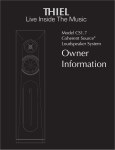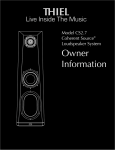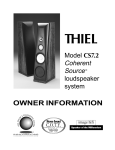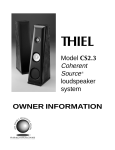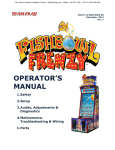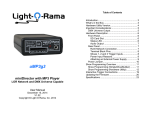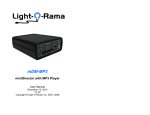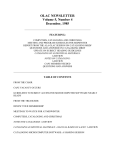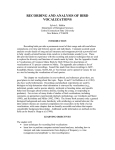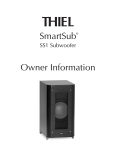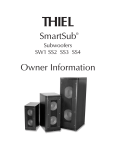Download Thiel Audio Products CS3.7 User's Manual
Transcript
THIEL Model CS3.7 Coherent Source ® loudspeaker system OWNER INFORMATION ® C ongratulations on your purchase of the THIEL CS3.7 Coherent Source ® loudspeaker system. The CS3.7 is the result of a long and dedicated effort to provide the most accurate music reproduction possible. We have used only the highest quality components and taken great care in the CS3.7’s construction. Properly set up and used with good associated equipment, the CS3.7 will provide a great deal of musical enjoyment for many years. CONTENTS Design philosophy..................................1 Positioning the speakers ....................... 2 Connecting the speakers ....................... 5 Leveling feet ......................................... 5 Break-in ................................................ 6 Associated equipment ........................... 6 Power requirements .............................. 6 Grille ..................................................... 7 Outrigger Base (optional) ..................... 7 Care ....................................................... 7 Service....................................................7 Warranty ............................................... 9 DESIGN PHILOSOPHY The CS3.7 is a precision instrument designed to translate, as accurately as possible, electronic information into musical sound. All our efforts have been directed toward achieving extremely faithful translation of all tonal, spatial and dynamic information supplied by the amplifier. The CS3.7 is not intended to mask or mitigate shortcomings of the recording or other components in the music playback system. We believe this approach is the only way to provide the potential of experiencing all the subtle aspects that help make reproduced music a most enjoyable human experience. Jim Thiel, Founder/Chief Design Engineer, THIEL Audio 1 POSITIONING THE SPEAKERS Because of their unipolar radiation pattern, the CS3.7s will provide good results when placed in a variety of room locations. However, speaker placement will affect the accuracy of timbre, spatial performance, and bass performance. Here are some guidelines to help you achieve the best sound from your speakers. (The pointed metal stabilizer pins should not be installed until the final positioning has been determined.) All aspects of speaker placement are dependent on the particulars of the room. Since every room is different, no hard rules can be given, and experimentation is necessary to achieve the best results. Distance from walls Direct sound Reflected sound The CS3.7s, like most speakers, sound best Difference in arrival times if they are placed well away from all walls. Such placement optimizes imaging characteristics, and musical timbres are reproduced with the least coloration because the initial sound coming from the speaker is distinctly separated in time from the secondary sound of wall reflections. If reflections are heard too soon after the primary sound, the brain tends to interpret them as part of the initial sound, causing the perceived timbre to be altered and the spatial characteristics to be confused. Figure 1. Early reflection problems caused by speakers placed Figure 1 illustrates the problems caused too close to side walls by early side wall reflections. When the speaker is placed too close to side walls, the Direct sound difference in arrival times between the Reflected sound Difference in arrival times primary sound waves and the reflected sound waves is too short for the brain to discriminate between them. Figure 2 illustrates the advantages of placing the loudspeakers farther from side walls. The arrival times of the primary, forward radiating sound waves and the secondary, reflected sound waves are well separated, providing the proper delay needed for faithful tonal and spatial reproduction. There will also be a noticeable improvement in openness when the speakers are even Figure 2. Optimum placement for reducing reflection problems two feet from the rear wall instead of one. If possible, we prefer the speakers three feet or more from the rear wall and five feet or more from the side walls. Also, it is not desirable for large objects to be placed very near the speakers since these will also be a source of unwanted early reflections that reduce imaging accuracy. 2 Spacing Because of their very wide, even dispersion of energy, the CS3.7s can usually be placed farther apart than most other speakers. Optimum imaging is usually achieved when the speakers are almost as far apart as each speaker is from the listener, although this will depend on the width of the room—narrow rooms require more narrow placement. If the speakers are too far apart for the room, there will tend to be a “hole” in the middle of the soundstage; if they are too close together, the image will be compressed and will not achieve optimum width. Aiming Depending on the room in which they are used, the CS3.7s can be aimed anywhere between straight ahead and angled in so they point directly at the listener. Straight-ahead placement produces the widest, most natural soundstage. However, if it is not possible to place the speakers the desired distance from side walls, a toed-in position will reduce the strength of side wall reflections and, in these cases, provide a more focused spatial presentation. Bass In general, when a speaker is close to a wall, the bass response is stronger; placing a speaker in a corner will make it even more so. The CS3.7s are designed to provide accurate bass when positioned away from all walls—the same position that provides the best imaging. Listener position The CS3.7s provide broad dispersion of energy at all frequencies and therefore provide good results throughout a large listening area. Best imaging is provided for a listener centered in front of the speakers. Optimum accuracy of timbre and depth perspective is provided for a seated listener who is eight or more feet away from the speakers. 14' 2.5' 3' 8' 8' 18' 3' 2.5' 10' Placement suggestions Some people have restraints on speaker placement because of room size, shape, or aesthetic considerations and cannot meet one or more of the above placement recommendations. They should not be discouraged from investing in CS3.7s. It is our opinion that due to their unipolar, point source radiation pattern, their very even, wide dispersion, and the co-axial mounting of the tweeter and midrange drivers, the CS3.7s fare better under difficult circumstances than most other high quality speaker systems. To help with placement, the following suggestions are given as a starting point for a variety of rooms. Figure 3 shows an average size room. Generally, it is best to start with short wall placement. This arrangement provides sufficient space behind the speakers, allows the listener to be far enough away from the speakers, and still maintains some distance between the listening position and the wall behind the listener. Since the speakers may be near side walls in order to keep spacing between the speakers wide, toeing-in the speakers is suggested. 8-10' Listening Distance Figure 3. Average listening room 3 4 18' 1' 1' 4' 10' 4' 10 ' 8' 14' 8-10 ' Listening Distance Figure 4. Average listening room with long wall placement 18' 3' 3' 8' 5' 8' 5' 12' Some rooms, especially narrow ones, can benefit from placing the speakers along the long wall. Although space behind the speaker and behind the listener is reduced, this positioning increases the space between the speakers without side wall interference, and can improve overall performance. Figure 4 shows the same average size room as Figure 3, but with long wall placement. The speakers should be at least a foot from the rear wall, but the amount of toe-in can be adjusted, along with listener position, as well as the amount of spacing between the speakers. In a larger room, the optimum positioning suggestions on pages 2 and 3 are easier to implement. Figure 5 shows one set-up with the speakers five feet from the side walls, three feet from the rear wall, and the speakers aimed straight ahead. This arrangement provides an ample amount of space around the speakers to reduce unwanted reflections and should give excellent spatial performance and a very “open” sound. Other placement options in this room include: wider spacing between the speakers, adding toe-in as the spacing increases; increased space between the speaker and the back wall to improve imaging depth. Various listening position distances can also be tried. As mentioned at the beginning of the positioning section, all rooms are different and no hard rules can be given. Even rooms with similar dimensions can have differences in wall, floor and ceiling construction that greatly affect the sound. Also, “live” rooms with hard surfaces, glass, and little damping sound much different from “dead” rooms with heavy carpet, drapes and plush furniture. In other words—EXPERIMENT. 25' 8-12' Listening Distance Figure 5. Large listening room speaker placement CONNECTING THE SPEAKERS The CS3.7’s input terminals are located on the lower rear of the speaker cabinet. The CS3.7 uses 5-way binding posts that accept several types of wire connections. Regardless of the type of wire termination, make sure that all connections are tight. The input terminals are designed to be easily tightened by hand or a 1⁄2 inch nut driver can be used. It is essential for proper performance that both speakers in a stereo system be wired in the same polarity. The speaker’s input terminals are color Bottom rear cabinet view coded to facilitate this. The wire connected to the red ringed input terminal of each speaker should connect to the respective positive (+) output terminals of the amplifier; the wire connected to the black ringed input terminals should be connected to the respective negative (–) output terminals of the amplifier. The speakers should be connected to the amplifier with high quality cable to ensure minimal loss of power and proper control by the amplifier. If the speakers are being connected to a vacuum tube amplifier with various impedance taps, the 4 ohm tap will usually give the best results. STABILIZER FEET The speakers should be positioned before the stabilizer feet are installed. lock nut Speakers positioned on a soft or uneven surface are able to rock slightly and will vibrate in reaction to forces the speaker generates to move the driver diaphragms. (Every action has an equal and opposite reaction.) This motion slightly reduces the music’s clarity. To eliminate this effect, the CS3.7s can be used with four stabilizer feet on uneven surfaces or on carpeted floors to provide a more solid footing and allow the speaker to couple more firmly to the floor. To install the feet: • Position the speaker in the desired location. • Tilt the speaker forward slightly so that the back of the speaker is a few inches off the floor. • Screw one foot, with the locking nut threaded all the way onto the foot, into each of the two holes at the back corners of the speaker bottom. The pins should be screwed into the Stabilizer Foot speaker until there is about 1⁄4" of thread remaining visible. • Let the back of the speaker down and then tilt the speaker backward slightly so that the front is a few inches off the floor and install the two front feet. • With all four feet installed, the height of each foot should be adjusted so that the speaker stands firmly on the floor without wobbling. Then tighten the lock nuts by turning them so they are tight against the cabinet to secure the feet to the cabinet Please be cautioned that the stabilizer feet can dent hardwood floors and it is possible to mar the floor’s surface if the speakers are moved with the feet in place. 5 BREAK-IN The CS3.7s, like most speakers, require a period of playing before they perform optimally. The time required depends on how loudly the speakers are played; more time is required if played softly, less if played loudly. At least 50 hours at moderately loud levels are required before the speaker is performing near optimum. You should notice even more improvement after 100 hours of playing. ASSOCIATED EQUIPMENT The CS3.7s are very high quality sound reproducers and will benefit from use with the finest associated equipment. Because the CS3.7 is a 4 ohm speaker, an amplifier with high current capability is recommended. It is desirable that the amplifier provide twice the power into a 4 ohm load as into an 8 ohm load. Since the CS3.7s are extremely accurate transducers, they will reveal distortions generated anywhere in the system. Also, the quality of the interconnect and speaker cables will significantly affect the performance of the system. POWER REQUIREMENTS It is important to have enough power to play at the level you desire without distortion. If you play the speakers more loudly than the volume the amplifier can cleanly produce, the amplifier will produce overload (clipping) distortion. The sound will become compressed, strained, and in extreme cases, obviously distorted. This distortion is actually nonmusical additional energy and since it is concentrated in the high frequency region where the speaker is least able to handle it, tweeters can be damaged in extreme cases. If high sound levels are desired, the CS3.7’s are designed to be used with amplifiers rated up to 600 watts per channel. Keep in mind that sound quality is usually more important than sound quantity. There can be large differences in the sonic performance of two amplifiers of equal power, and this is more important than large differences in power. Most everyone will be happier with a 100 watt amplifier of high sonic quality than a 200 watt amplifier of mediocre sonic quality. For this reason, we feel there is no substitute for listening in making your amplifier decision. The question “how much power do I need?” does not have the simple answer most people expect because it is not determined only by the loudspeaker’s efficiency, but also by the volume desired and the size of the room. If all three factors are average, about 100 watts per channel is required. Each factor can raise or lower this amount by about three times. 1) Usually, people who “don’t like music loud” can decrease their power to about one-half. Also, people who like music loud should increase their power by 2 times or more. Most people fall within a normal range. 2) A speaker with a low efficiency of 84dB/2.8 V-1-m will require twice the power of an average 87dB/2.8 V-1-m speaker and one with a high rating of 90dB/2.8 V-1-m will require only half the power of an average speaker. The CS3.7 is of high efficiency (90dB) and therefore can work well with smaller amounts of power from a quality amplifier. 3) A small room will need less power for a given loudness level than a large room. A very small room of 1000 cu ft (11' x 11' with an 8' ceiling) will require about half the power of an average size room. A large room of 6000 cu ft (20' x 30' with a 10' ceiling) will require twice the average power. If the listening room is connected to another room by a large open area, the required power will increase, but not by the amount of the combined room volume. If the room has a “dropped” ceiling with light panels, the ceiling will be almost transparent acoustically and the space above the ceiling should be added. If the panels are heavy they will act as a more normal ceiling. With all this in mind, a person who doesn’t like to play music very loudly and has a small room can get quality sound with 50 watts or even less whereas a person who sometimes likes to play loudly and has a large room may need 400 watts or more. 6 GRILLE The CS3.7 grille is attached magnetically to the front of the speaker. The grille is designed to not produce diffraction so there is no sonic reason to remove it. If you do need to remove the grille, carefully pull the grille frame away from the front of the speaker. When replacing the grille, line up the grille with the baffle’s inlay edges. OPTIONAL OUTRIGGER BASE The CS3.7s can be used with an optional Outrigger base (shown right). The Outriggers attache to the bottom of the speaker cabinet with four mounting bolts (provided with the Outrigger) screwed into the four threaded openings normally used for the speaker’s stabilizer feet. Complete installation instructions are included with the Outriggers. CARE The cabinets possess a high quality lacquer finish that is both beautiful and durable. However, any wood finish can be damaged by excessive moisture, dryness, or direct sunlight. When cleaning your speakers, avoid using oils, waxes, or polishes that contain silicone. We recommend Endust. Dusty grilles can be cleaned by using the upholstery attachment of a vacuum cleaner. SERVICE If your speaker system requires service, contact your authorized THIEL dealer. If you need to contact THIEL directly, service information and technical support is available at (859) 254-9427, Monday-Friday, 8:30 a.m. 5:00 p.m. Eastern Time, or via e-mail at [email protected]. THIEL dealer information and a “Frequently Asked Questions” section can be found at our web site, www.thielaudio.com. CS3.7 with optional Outrigger Base 7 CS3.7 SPECIFICATIONS Bandwidth (–3dB) 32 Hz-35 kHz 33Hz-22 kHz ±2 dB Amplitude Response Minimum ±10° Phase Response Sensitivity 90 [email protected] V-1m Impedance 4 ohms (2.8 ohms minimum) Recommended Power Size (w x d x h) 100-600 watts 12.5 x 21x 45 inches 32 x 53 x 114 cm Weight 91 lbs/ 41.5 kg We Want You Listening For A Lifetime Used wisely, your new sound equipment will provide a lifetime of enjoyment. Since hearing damage from loud noise is often undetectable until it is too late, THIEL and the Electronics Industries Manufacturers Association recommend you avoid prolonged exposure to excessive noise. Depending on room size and amplifier power, some home audio systems can reach sound pressure levels in excess of 95 decibels with peaks of over a 105 decibels. For your protection, the list below identifies sound levels for various noises. Decibel Level Example 30 40 50 60 70 80 8 Quiet library, soft whispers Living room, refrigerator, bedroom away from traffic Light traffic, normal conversation, quiet office Air conditioner at 20 feet, sewing machine Vacuum cleaner, hair dryer, noisy restaurant Average city traffic, garbage disposals, alarm clock at two feet The Following Noises Can Be Dangerous Under Constant Exposure 90 100 120 140 150 Subway, motorcycle, truck traffic, lawn mower Garbage truck, chain saw, pneumatic drill Rock concert in front of speakers, thunderclap Gunshot blast, jet plane Rocket launching pad Information courtesy of the Deafness Research Foundation and the EIA. LIMITED WARRANTY THIEL warrants every THIEL model CS3.7 system against defects in materials and workmanship to the original owner for a period of ten years from the date of purchase. THIEL will, at no charge, replace any defective part and make any repairs necessary to ensure its proper performance when the defective unit is returned to us postpaid. This warranty does not cover damage due to accident or abuse and is void if the unit has been tampered with. This warranty is automatic and no registration is required. This warranty gives you specific legal rights. You may also have other rights which are particular to your state. The following information is for your records. Serial Numbers______________________________ Purchase Date_______________________________ Purchased From_____________________________ REGISTER YOUR 10 YEAR WARRANTY ONLINE AT www.thielaudio.com/registrations/new 9 THIEL 1026 Nandino Boulevard, Lexington, Kentucky 40511-1207 Telephone: 859-254-9427 • E-mail: [email protected] • Web: www.thielaudio.com 4/07 04/07












